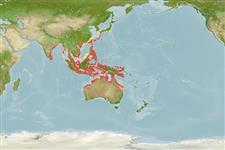Environment: milieu / Klimaatzone / Diepte / distribution range
Ecologie
marien; brak water rifbewoner; diepte 1 - ? m (Ref. 48637), usually 1 - 20 m (Ref. 27115). Tropical; 23°C - 28°C (Ref. 27115); 35°N - 25°S, 77°E - 154°E
Indo-West Pacific: southern India, Sri Lanka, Andaman Islands, Thailand, southern and eastern coasts of China, Taiwan, Ryukyu, Philippines, Malaysia, Singapore, Indonesia and Northern Territory in Australia.
Grootte / Gewicht / Leeftijd
Maturiteit: Lm ? range ? - ? cm
Max length : 30.0 cm TL mannelijk / geslacht onbekend; (Ref. 9710); common length : 20.0 cm TL mannelijk / geslacht onbekend; (Ref. 9813)
Dorsale stekels (totaal) : 13; Dorsale zachte stralen (totaal) : 10; Anale stekels: 7; Anale zachte stralen: 9; Wervels: 13. A brown band running diagonally from nape to chin; another from 4th-5th dorsal spine base to pectoral fin base; ocular and shoulder bands spotted with blue; a zone of silvery yellow posterior and adjacent to the shoulder band. Preopercular angle 100°-111°; cheek scalation variable from few to almost fully scaled; midline of thorax fully scaled, sometimes with a row missing from pelvic ridges. A prominent rim or short tube encircle the anterior nostril, with a little peak on it posteriorly. Spines stout, fairly pungent and venomous.
Body shape (shape guide): short and / or deep; Cross section: compressed.
Inhabits shallow coastal waters, around hard coral reefs and areas of sand with patches of rock and soft coral. Tolerant of murky waters. Larger juveniles and adults occur in pairs in coastal reef flats, slopes and estuaries . Small juveniles are found in mangroves and enter freshwater, moving to reefs usually in small groups among corals (Ref. 48637). Feed on benthic seaweeds (Ref. 9813).
Levenscyclus en paargedrag
Maturiteit | Voortplanting | Paaien | Eieren | Fecunditeit | Larven
Woodland, D.J., 1990. Revision of the fish family Siganidae with descriptions of two new species and comments on distribution and biology. Indo-Pac. Fish. (19):136 p. (Ref. 1419)
Status op de Rode Lijst van het IUCN (Ref. 130435: Version 2025-1)
Gebruik door de mens
Visserij: van minder commercieel belang; Aquarium: Commercieel
Tools
Speciale rapporten
Download XML
Internetbronnen
Estimates based on models
Preferred temperature (Ref.
123201): 25.4 - 29.1, mean 28.3 °C (based on 1192 cells).
Fylogenetische diversiteitsindex (Ref.
82804): PD
50 = 0.5000 [Uniqueness, from 0.5 = low to 2.0 = high].
Bayesian length-weight: a=0.01905 (0.01036 - 0.03504), b=3.13 (2.97 - 3.29), in cm total length, based on LWR estimates for this species & Genus-body shape (Ref.
93245).
Trofisch niveau (Ref.
69278): 2.7 ±0.31 se; based on food items.
Weerstandsvermogen (Ref.
120179): Hoog, minimale populatieverdubbelingstijd minder dan 15 maanden (Preliminary K or Fecundity.).
Fishing Vulnerability (Ref.
59153): Low vulnerability (20 of 100).
🛈
Nutrients (Ref.
124155): Calcium = 38.5 [18.8, 90.0] mg/100g; Iron = 0.671 [0.313, 1.534] mg/100g; Protein = 19 [18, 20] %; Omega3 = 0.121 [0.063, 0.240] g/100g; Selenium = 20.3 [7.8, 50.6] μg/100g; VitaminA = 33 [9, 121] μg/100g; Zinc = 1.42 [0.56, 3.07] mg/100g (wet weight);
